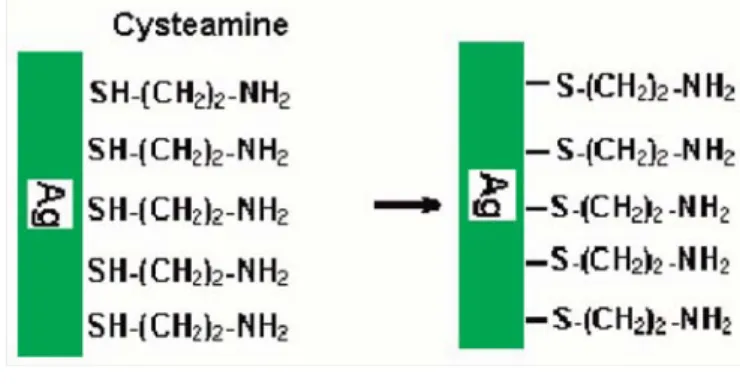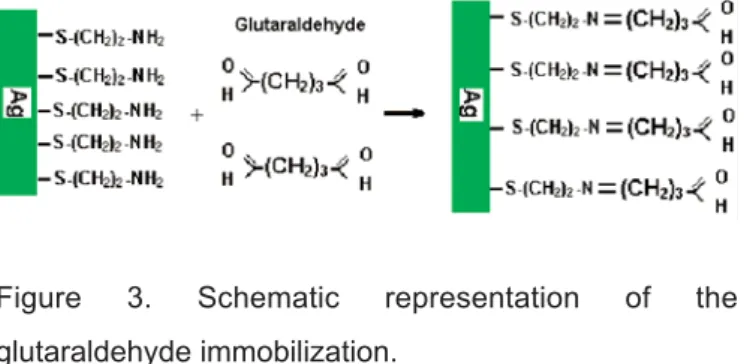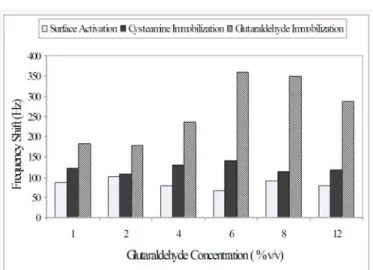HACETTEPE JOURNAL OF BIOLOGY AND CHEMISTRY
INTRODUCTION
The interaction between biological molecules and the surface to be immobilized are important on biological behaviour of molecules. The active site of biological substances is often located deep within the molecule. Adsorbent prepared by coupling small ligands directly to matrix can exhibit low capacities due to steric hindrance between the matrix and the substances to be attached. In this circumstance a spacer arm is interposed between the matrix and the ligand to facilitate binding [1]. Methods are available for immobilizing ligands. The correct choice of coupling method depends on the substance to be immobilized. The matrices can be activated by several methods. Quartz Crystal Microbalance (QCM) sensors can be also prepared by using these activation methods.
(QCM) is a high sensitive device among the biosensing methods. Many advantages exist for QCM biosensors i.e. simplicity, convenience, economical cost, real time response. Therefore QCM have been examined in the fields of food analysis, clinical analysis, environmental monitoring, and one gene probe assay for their potential applications [2].
Nanosized particles have become important employability in modern technology systems due to their high surface area, different optic and optical properties. Polystyrene, polymethyl methacrylate, inorganic PbS, Ag2S, CdSe, TiO2, Au, Ag, etc nanoparticles have been produced for various applications [3-8]. These nanoparticles can be produced by microemulsion polymerization, reverse micelle formation, electro-deposition. The nano-particles can be replaced to Au, Al, glass, silica etc. substrate surfaces by physical or chemical methods to formation of regular nano orderly structures.
Quartz Crystal Piezo Electrode Surface Modification for Gold
Nano-particles Immobilization
Fatma Ayhan, Aydan Gülsu, Hakan Ayhan*
Mugla University, Department of Chemistry, Biochemistry Division, Mugla, Turkey
Abstract
In this study silver electrode quartz crystal surfaces were cleaned and modified to immobilize gold nanoparticles. First, the crystal surfaces were cleaned and activated with sodium hydroxide, acetone and methanol. After the cleaning and the activation process, first cysteamine immobilization stage was performed in phosphate buffer (pH=7.0). Glutaraldehyde was used as a spacer arm and immobilized on the electrode surfaces in tetraborate buffer (pH 8.2). After then, second cysteamine immobilization step was achieved. Frequency shift were measured in all of the modification steps. Gold nanoparticles were immobilized on the modified surfaces by self-assembled monolayer (SAM) formation, for expanded crystal surface.
Key Words: Surface modification, self-assembled monolayer, gold nanoparticles Immobilization.
* Correspondence to: Hakan Ayhan
Mugla University, Department of Chemistry, Biochemistry Division, 48000 Kötekli/ Mugla, Turkey.
Tel: +90 252 211 15 06 Fax: +90 252 223 86 56 E-mail: hayhan@mu.edu.tr
Research Article Hacettepe J. Biol. & Chem., 2007, 35 (3), 203-208
---'-The aim of this work is to investigate the effect of surface chemical modification parameters. For this purpose silver electrode quartz crystal surfaces were cleaned and modified by series of chemical treatment process of the electrode surface to immobilize gold nanoparticles by self-assembled monolayer (SAM) formation. This modification stages were determined by measurement of frequency shift with QCM apparatus. Gold nanoparticles were immobilized on the piezo crystal surface by Au-SH bond to obtain suitable surface for a biomolecule attachment.
MATERIALS AND METHODS
Materials
Sodium hydroxyde (NaOH), acetone (CH3COCH3), methanol (CH3OH), (C2H7NS), Na2HPO4 -NaH2PO4, glutaraldehyde, tetraborate, HCl, cys-teamine, were purchased from Sigma, Silver Piezo Crystal was purchased from MEC Quartz Limited Honkong&mainland China.
Cleaning and activation
The cleaning and activation of silver electrode is very important processes for self-assembled monolayer formation. So, it needs to be carried out systematically. Frequencies of crystals were measured before modification steps begin. Silver electrodes cleaning process described briefly as follows. The crystals were first reacted with 0.5 M NaOH for 30 min, then, 30 min with acetone and methanol, respectively. Silver electrodes were cleaned up from all residues by the washing. And at last, electrodes were washed with deionized water (pH: 7) for 30 min to remove physically adsorbed molecules on electrode surface. Crystals were kept at 37oC for 30 min. and the frequency dried crystals
were measured.
Figure 1. Schematic representation of cleaning and activation process.
The First Immobilization of Cysteamine
After cleaning and activation seteps, cysteamine which has bi-functional groups was immobilized on crystal surface. For this purpose cysteamine was dissolved in phosphate buffer (0.1 M pH: 7). Cysteamine immobilization experiments were performed to obtain optimum immobilization concentration (6, 10, 12, 14, 18, 22, 24 mM). The crystals were kept in prepared solutions for 2 h at
Figure 2. Schematic representation of the first cysteamine immobilization.
dark. Then crystals were washed with deinozied water water for 15 min. The crystals were dried at 37oC for 30 min. and frequency values were
meas-ured.
Glutaraldehyde (GA) Immobilization
Glutaraldehyde was used as spacer arm. Cysteamine immobilized crystals were reacted with % 1-12 (v/v) glutaraldehyde solution in sodium tetraborate/HCl buffer (pH; 8.2) at dark for 2 h. Then washed with deionized water and dried at 37oC for
Cysteamine SH-(CHz)2-NH2 SH-(CH2)2-NH2 S H-( CH2lz-N H2 S H-1 CH2b-N H2 S H-1 CH2b-N H2
---S-(CH2h-NH
2
-S-(CH2)2-N Hz•
(C -S-(CH2)2-NH2 -S-KH2)2-NH2 -S-(CH2h-N H230 min. Frequency values were measured.
Figure 3. Schematic representation of the glutaraldehyde immobilization.
The Second Cysteamine Immobilization
Glutaraldehyde bonded crystals were reacted with second cysteamine. As mentioned above same procedure as first cysteamine immobilization was performed to immobilize the second cysteamine to glutaraldehyde bonded crystal. In this step cysteamin concentration was optimum whic was obtained for first cysteamine immobilization process. Then washed with deionized water and dried at 37oC for 30 min. Frequency values were measured.
Figure 4. Schematic representation of the second cysteamine immobilization.
Gold Nanoparticle Immobilization
In this part of the study, the silver electrodes were treated with gold nanoparticles in order to provide linkage to thiol end of cysteamine to form self-assembled monolayer. Gold nanoparticles were synthesised and characterized in our previous aricle [9]. For this purpose, the quartz crystals were immersed in gold nanoparticle solution for 2 h. In order to perform self-assemble method successfully gold nano particles to be immobilized should be
monosize. After immobilization of gold nanoparticle the crystals were washed with deionized water for 15 min. and then dried at 37oC for 30 min.
Frequency values were measured.
Quartz Crystal Microbalance Apparatus and Frequency Measurement
A handmade QCM apparatus was used in this study. The construction details of the instrument were given elsewhere [10]. Briefly explained, the QCM apparatus has made up of three main parts: two crystal oscillators, temperature controlled conditioning chamber and frequency differentiator. The crystal oscillators are well known collpits oscillators where all of their components and quartz crystals were placed in temperature controlled chamber. All the experiments were carried out with commercially available quartz crystals where AT-cut 10 MHz quartz crystal (MEC Quartz Limited Honkong & mainland China) of 8.7 x 0.17 mm wafer is placed between 4.7 mm silver electrodes were used with these oscillators. The temperature control of the chamber was achieved with a microcontroller (PIC 16F877) where the temperature control range of chamber was designed to work from room temperature up to around 70°C. PWM pulses were used to drive power transistors and heater. Temperature was measured by using semi conductor sensor of LM35. In order to obtain frequency difference (Df) of two oscillators, a high frequency mixer with dual gate MOSFET (3N200) and a passive low pass filter were placed. The Sauerbrey equation was used to present the relationship between the frequency change and the change of the quartz electrode mass in the air [11] ∆F= -2.3 x 10-6.
All of the results were given as the average of three experiments. -S-(CH;J,-N H2 Glutaraldehyde -S.(Cf½J,.NH, ~ ~(CH2)J{ ~ a:ı: -S.(Cıt,J,.Ntı, + -S .(C 11,)ı-N 11, - S.(Ct½h-NI½ S-ICHılı-N = (CHı)ı{' O H S-ICHılı-N
=
(CHı)ı{ O H + S-ICHılı-H = (C H.ı)ı{" o H S-iCH~ı-H = (CHı)ı{ o H Cysteamino SH~CHılı-NH2 SH-(C Hılı-N Hı -- (D S-(CH,h-N = (CH2h.Z O H S.(CHe)ı-N = (CH2)3-{: o H S.(CH,);ı-H = (CHıh-{: o H S-(CH2)ı-N=(CH2h{ Q H S-(CH,lı-N = (CHı)ı = N.(CHı)ıSH S~CHılı-N=
(CHı)ı = N(CHılı-SH S~CHılı-H = (CH.ı)ı=
N-(CH.ı)ı-SH S-iCHılı-N =(CHıh=
H.(CHılı-SHRESULTS AND DISCUSSION
Frequency differences were detected between the beginning step, cleaning step and activation step on the crystal surfaces. Crystal surfaces were bonded from –OH group on crystal surface which are coming from cleaning solutions. The frequency differences were detected as 10020 Hz for each step. The rising and falling frequency values observed is not comprehensible. Additionally, the original frequencies of the silver crystals were not the same for everytime but deviations were not as the value depicted above.
First Cysteamine Immobilization
Cysteamine has two functional end groups as a thiol (SH) and amine (NH2). Cysteamine was linked to Ag crystal surface through weak acid-base reaction between thiol groups and Ag. In this part, the effect of cysteamine concentration on immobilization was investigated. Maximum frequency shift was observed at 18 mM cysteamine initial concentration (Figure 5).
Figure 5. The effect of initial cysteamine concentration on the cysteamine immobilization.
On the other term, maximum cysteamine immobilization was performed on electrode surface at this cysteamine concentration values. Similar study had been performed by Herne in 1997 [12] were reported that when maximum cysteamine
immobilization caused more effective glutar-aldehyde immobilization.
Glutaraldehyde Immobilization
After the first cysteamine immobilization, glutar aldehyde (GA) immobilization experiments were performed to investigate its concentration effect. Small frequency differences concentrations were bserved at low GA. The highest frequency shift was obtained for 6% v/v GA concentration and selected as optimum value.
For higher concentrations of GA, frequency decreases may be due to the formation of polyglutar aldehyde and binding of two aldehyde groups of glutar aldehyde with the amino groups of cysteamines.
Thus, it leads to decrease of thiol groups of cysteamine and available groups for GA coupling. In a similar study, Wang and co-workers were reported that suitable glutaraldehyde concentration was 0.6% for Schiff base reaction between cysteamine and glutar aldehyde [13].
Figure 6. The effect of GA concentration (First Cysteamine conc. 18 mM).
r
100 140 N 120 6 ~ 100 ~ >. 80 '-' -g 60 5-e 40 "-20 o~
61 • Surfücc octi\lrıtion fırsı Cysıeııminc: lrrarı)hilinııion 1
_ır
--
-ııı -1 :ı.ı ·•-10 12 ,~ 1 22 Cysıcaminc ConccnITT11ion (mM)-u
2-l• ııface Activaıion l Cysıcaniııc hımılıiliıııtion ili Clıttır.ıldehyde lmmbıli7aıion
.ıx:ı~---~ -50 'B" 300
=
250 c::: ~ :;ro~
150 i ım 50 o 2 6 8 12 Ouıuııldel~ Coıx:eınatm ( %~Second Cysteamine Immobilization
After glutaraldehyde immobilization, the second cysteamine was reacted with glutaraldehyde immobilized crystal by Schiff base reaction. In this reaction chemical binding of aldehyde group of GA and amine group of cysteamine was realized. It was aimed to constitute the free end the thiol groups of cysteamine which will provide suitable chemical bonding with gold nanoparticles in the next step.
Figure 7. The effect of cysteamine concentration on the second cysteamine immobilization (GA conc. 6%, First Cysteamine conc. 18 mM).
The same initial concentration search studies were performed for the second cysteamine immobili-zation like previous cysteamine immobiliimmobili-zation.
Figure 7 depicts the change of frequency shift with cysteamine concentration. Figure 8 shows that only small fluctuations were recorded and the highest shift values were found for 6, 18 and 22 mM cyteamine concentrations. It is clear that the immobilization of second cysteamine depends on previous GA immobilization step.
Hence, the second cysteamine concentration was selected as 18 mM for the sake of simplicity and facility.
Gold Nanoparticle Immobilization
Finally gold nanoparticles immobilization studies were performed after modification of crystal surfaces. Gold nanoparticles with 235nm diameter were selected for immobilization. Gold nanoparticle size is another important parameter to obtain expanded surface area. Small and monosize particles increase surface area and facilitate the crystal surface coverage. Systematic surface properties strongly depends on crystal surface morphology. Crystal surfaces, before and after gold nanoparticles immobilization were shown compara-tively in Figure 8. Monolayer coating were successfully achieved on smooth parts of electrode surfaces. However, the aggregate formation was observed on bad shaped area and deep valley.
Figure 8. SEM images of silver surfaces; a) before immobilization, b) after immobilization.
• &uface.ıctİ\11tiaıı • Frrst Cystemıirıe uaummklehydc • SecııııdCysıem,iı-.,
-0) 350 :(O :B' 6 250 c= ~ xo
[
150 g-t.i: 100 50 o 6 10 12 14 18 22 2-1 C~nirı:: Coruıtrati:ın (m\1)CONCLUSION
Silver electrode of piezo crystals were successfully modified by chemical treatment. Silver electrode quartz crystal surface provided more expanded area by gold nanoparticle immobilization. This leads to decrease of temperature and humidity sensitivity on crystals which is a preferred property in order to eliminate this important disadvantage of the crystals. Another important conclusion is that high surface area and functionality will provide high immobilization capacity for a biological molecule, which is an important advantage in biosensor applications.
REFERENCES
1. Shubo, H.A., three-dimensional heterogeneous DNA sensing surface formed by attaching oligodeoxynucleotide-capped gold nanoparticles onto a gold coated quartz crystal, Chem. Commun., 7 (2001) 609 .
2. Zhou, X.C., Microgravimetric DNA sensor based on quartz crystal microbalance: comparison of oligonucleotide immobilization methods and the application in genetic diagnosis, Biosensors and Bioelectronics, 16 (2001) 85.
3. Göpel, W. Bioelectronics and nanotechnologies, Biosensors and Bioelectronics, 13 (1998) 723. 4. DeSilva, A. P. Gunaratne, H. Q. N. McCoy, C. P., A
molecular photoionic and gate based on fluorescent signalling, Nature, 364 (1993) 42.
5. Andrew N. Shipway, Nanoparticle Arrays on Surfaces for Elektronic, Optical and sensor applications, CHEMPHYSCHEM, 1 (2000) 18.
6. Csáki, A. DNA monolayer on gold substrates characterized by nanoparticle labeling and scanning force microscopy, Nucleic Acids Research, 29 (2001) 16.
7. Kimura, K. and Takashima, S., Molecular Approach to the Surface Potential Estimate of Thiolate-Modified Gold Nanoparticles, J. Phys. Chem. B, 106 (2002) 7260.
8. Lvov, Y., Munge, B., Giraldo, O., Ichinose, I., Suib, S.L., Rusling, J.F., Films of manganese oxide nanoparticles with polycations or myoglobin from alternate-layer adsorption. Langmuir, 16 (2000) 8850.
9. Tabrizi, A., Ayhan, F., Ayhan, H., Gold Nanoparticle Synthesis and Characterisation For self-assembled monolayer Immobilization on to Piezo Crystal surfaces, Journal of Biomaterial Science, Polymer Edition, (2008), submitted. 10. Koçum, C., Erdamar, A., Ayhan, H., Design of
Temperature Controlled Quartz Crystal Microbalance System, Review of Scientifi Instruments, (2008) submitted.
11. Sauerbrey, G., Verwendung von Schwingquarzen zur dunner Schichten und zur. Z Phys., 155 (1959) 206.
12. Tonya M. Herne and Michael J. Tarlov, Characterization of DNA Probes Immobilized on Gold Surfaces, J. Am. Chem. Soc., 119 (1997) 8916.
13. Wang, J., Flow injection amperometric detection of OP nerve agents based on an organophosphorus– hydrolase biosensor detector, Biosensors and Bioelectronics 18 (2003) 255.



